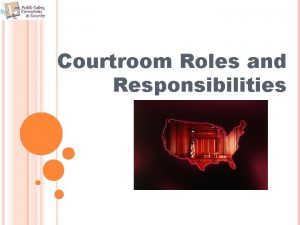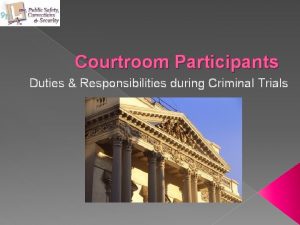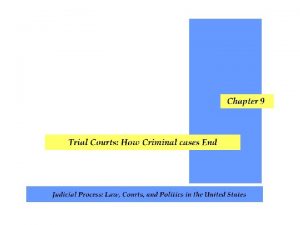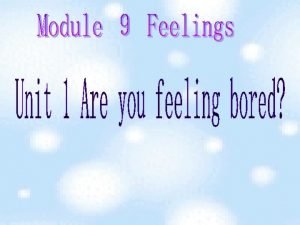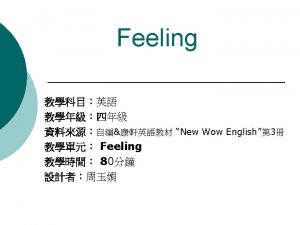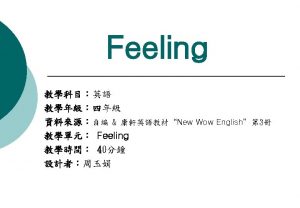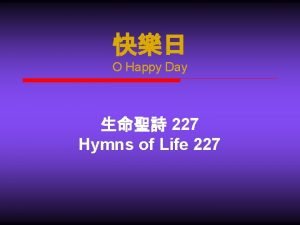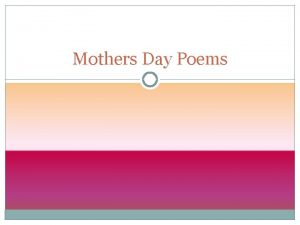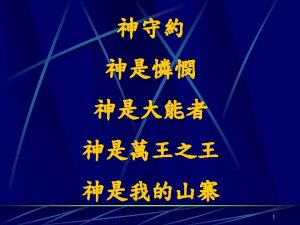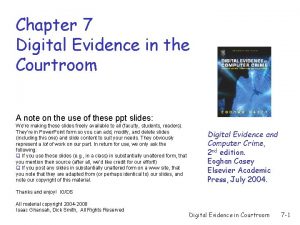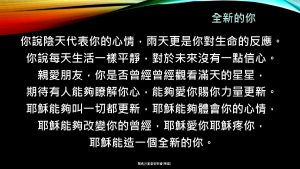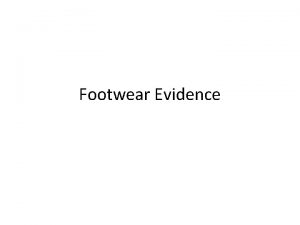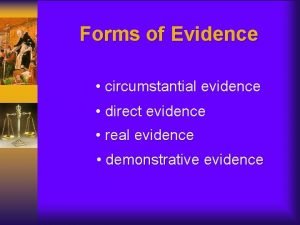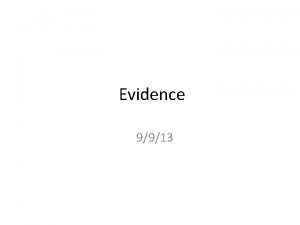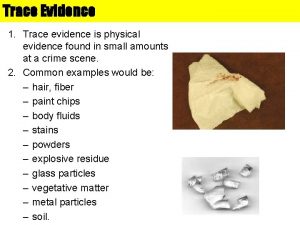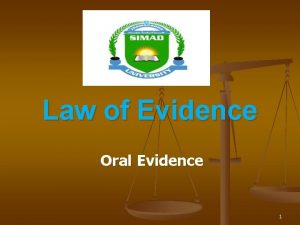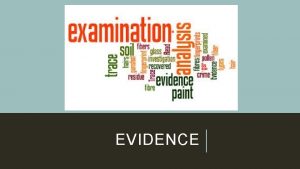Happy Day Todays Topics Evidence in a courtroom


































- Slides: 34

Happy Day! • Today’s Topics: – Evidence in a courtroom – Death

Intro to Forensic Science

What is Forensic Science? • Application of science to law

Locard’s Exchange Principle • Cross transfer of physical evidence • Intensity, duration, nature of the materials in contact determine the extent of the transfer. Crime Scene Victim Suspect

Types of Evidence Direct Circumstantial Physical Biological

Direct Evidence • 1 st hand observations, eye witness accounts, police dashboard video camera • Requires no inference. BACK

Circumstantial • Indirect that can be used to imply a fact but not directly prove it. Requires an inference.

Death • Irreversible cessation of circulation of blood – process, not an event.

Stages of Death Heart stops beating-blood no longer pumped O 2 decreases = stoppage of nerve, muscle, organs, and brain. Cell dies and breaks down (autolysis) Cell membrane dissolves (Putrefaction) Enzymes and chemicals spill out and digest surrounding tissue.

What happens to a body after a person dies? • Normally the body gets embalmed and preserved to delay decomposition for viewing hours and a funeral. • If the cause of death is questionable an autopsy is typically performed.

Happy Monday! • Today’s Topics: – Autopsy – Manner of Death – Time of Death – MORTIS

What is an autopsy? • Examination of a dead body to determine manner, cause, mechanism of death (done by forensic pathologist)

Manner of death Natural Accidental Suicidal Homicidal Undetermined

Cause • Cause of death- reason/disease, stroke, burning, drowning – Proximate Cause of Death- underlying cause as opposed to final cause.

Mechanism of Death • Specific change in the body that brought about the death – Ex. Cause = shooting • Mechanism= loss of blood

Time of Death (post mortem interval, PMI time since death) • Liver Mortis (Death Color) • What is it? • Blood seeps down through tissues and settles into lower parts of the body. • How does it happen? – RBC’s breakdown, spilling their contents which includes hemoglobin (giving blood its red color) turning purple. Purple color is visible on parts of the skin where ever blood pools. • What is lividity? – Pooling of blood

Liver Mortis cont’d • Timeline – 2 hours after death, pooling of blood begins – 8 hours after death, discoloration is permanent • (2 -8 hours after death- lividity is present, but if the skin is pressed, color disappears) • (8+ hours after death the discoloration is permenant)

Liver Mortis cont’d • External Influences – Air temperature (Hot=faster/Cold=slower) – Also might be impeded by tight clothing or being overweight

Rigor Mortis (Death Stiffness) • What is it? – Muscles are unable to relax, so they remain contracted. – How does it happen? • Living muscle fibers are constantly flexing and contracting. Fibers slide over one another when they contract, releasing Ca which is removed with the help of energy. In death there is no energy to remove Ca so it accumulates and muscles remain contracted. – Not permanent b/c muscle fibers/cells eventually die or dissolve by autolysis.

Rigor Mortis Timeline 2 -6 hours rigor begins with eyelids and jaw muscles. 12 hours rigor is complete through entire body. 15 -36 hours slow loss of rigor, 1 st lost in the head and neck, later in the legs. 36 -48 hours rigor totally disappears.

Rigor Mortis Cont’d • External Influences Ambient (air) Temperature A person’s weight, body fat stores O 2, slows rigor Type of clothing keeps it warm Illness Level of physical activity shortly before death Sun Exposure

Algor Mortis (Death Heat) • Temperature loss in a corpse – Liver is used as the location to take temperature (standard)

Algor Mortis cont’d • First 12 hours=. 78 degrees loss/hour • After first 12 hours=. 39 degees loss/hour

Algor Mortis cont’d • External Influences – Surrounding temperature – Body fat/clothing

Other Methods to Determine TOD (Time of Death)

Methods to determine TOD 1) 2) 3) 4) Stomach Contents Changes of the Eye Decomposition Forensic Entomology (Study of Insects)

Stomach Contents Timeline Next 12 hours food leaves the 4 -6 hours intestines stomach empties in small intestines 24 hours undigested food leaves the colon Back

Changes of the Eye Timeline • 2 -3 hours thin film (if eyes open) 24 hours if not – K+ builds up in the vitreous humor- may be used to calculate TOD Back

Decomposition Rotting of all tissues and organs. Occurs due to bacteria and other microorganisms.

Decomposition Timeline 2 days • Cell autolysis begins • Green and purplish staining occurs form blood • Skin looks marbled • Face becomes discolored 4 days Skin blisters Abdomen swells as bacteria in intestines releases CO 2 6 -10 days Corpse bloats with CO 2 eventually causing chest and abdomen cavities to burst and collapse. Fluid leaks, eyeballs liquify and skin sloughs off.

Decomposition Key Words 1) Putrefaction – odor of decaying flesh is present and corpse appears swollen 2) Black putrefaction- very strong odor, parts of flesh appear black, corpse collapses as gases escape. 3) Butyric putrefaction- corpse is beginning to dry out, most of the flesh is gone. Back

Forensic Entomology (study of insects) • Environmental conditions are necessary to know to determine TOD. • Blowflies are one of the first insects to arrive at a dead body…and therefore are useful in determining TOD. • ADH (accumulated degree hours) is the process of collecting insects from crime scene raising them in a lab under the same condition.

ADH • Calculated – Immediately preserving insects form the crime scene. – Raising the insects in a lab.

 Day 1 day 2 day 3 day 4
Day 1 day 2 day 3 day 4 I am happy to know that ghi
I am happy to know that ghi Day 1 day 2 day 817
Day 1 day 2 day 817 Courtroom roles
Courtroom roles Courtroom work group
Courtroom work group Courtroom
Courtroom What is the purpose of the courtroom work group
What is the purpose of the courtroom work group Non professional courtroom participants
Non professional courtroom participants Courtroom roles and responsibilities
Courtroom roles and responsibilities Courtroom work group members
Courtroom work group members Courtroom layout
Courtroom layout Happy feet happy life
Happy feet happy life Sad happy bored
Sad happy bored Happy sad angry sleepy
Happy sad angry sleepy Hungry
Hungry Problem focused trigger
Problem focused trigger Primary evidence vs secondary evidence
Primary evidence vs secondary evidence Individual evidence can have probative value.
Individual evidence can have probative value. What is a primary source
What is a primary source Primary evidence vs secondary evidence
Primary evidence vs secondary evidence Class vs individual evidence
Class vs individual evidence Primary evidence vs secondary evidence
Primary evidence vs secondary evidence Fiber evidence can have probative value as class evidence.
Fiber evidence can have probative value as class evidence. Define ecological fallacy
Define ecological fallacy Primary evidence vs secondary evidence
Primary evidence vs secondary evidence Class vs individual evidence
Class vs individual evidence Happy hymns
Happy hymns Proverbs 31:28-29 esv
Proverbs 31:28-29 esv Happy saint valentine
Happy saint valentine Happy sad poems
Happy sad poems Oh happy day
Oh happy day Sid bobb
Sid bobb Mothers day finland
Mothers day finland Happy day market
Happy day market Happy ashley day
Happy ashley day



